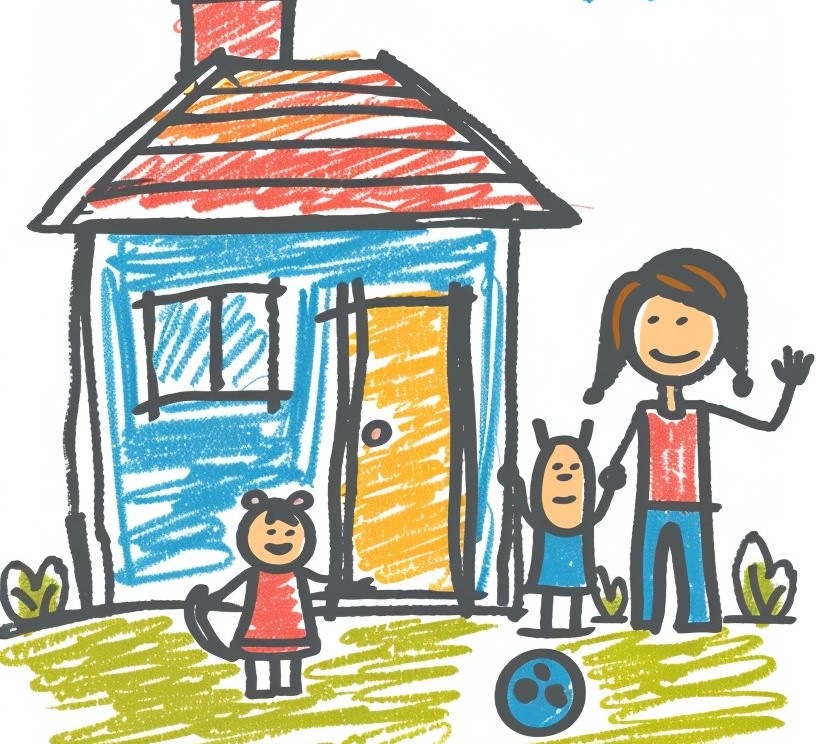WHAT IS A HOME ?
“I lived there for more than a decade but couldn’t call it my home”, said the terrible soul of a young girl sitting alone on a weathered bench. Loneliness seemed to shadow the bench, dawn painted the sky in soft hues, and silence held the street in its quiet embrace. Yet, for this girl, that bench was a sanctuary, a rare place of solace. I was with my parents, making our way to the railway station to catch the train that would take me to the city of my dreams for my higher studies. As we passed, I noticed her sitting there, a picture of quiet desolation. Compelled by something unspoken, I approached her. We conversed for just five minutes over her melancholy rooted in her home that does not title her as their family member because she was adopted by the grandfather of that home who passed away a week ago. I was handcuffed with the time constraints as had to catch my train and so our conversation could not be completed.
Precious moments slipped away as I edged closer to my departure. But in those fleeting minutes, something profound unfolded from that short conversation—a vision of life and home that few are privileged to absorb. Her words lingered with me, adding weight to the already heavy burden of farewells. Saying goodbye to my memories, the comforting warmth of my parents, and the familiarity of my hometown was a bittersweet ordeal. Each step away felt like tearing a piece of my heart from its roots, yet there was a promise of new beginnings that beckoned.
As I settled into my seat on the train, the whistle blew, signaling the start of a new journey. The rhythmic chug of the engine mirrored the pounding of my heart. The scenery outside the window blurred, a tapestry of past and future, as the train sped forward. That girl’s story, her quiet resilience, and the weight of her words stayed with me, enriching my journey with a deeper understanding of what it means to search for home.
After the initial pangs of nostalgia, I found myself settling into the rhythm of a new city. As the first year of my studies ended, I discovered some amount of solace in that unfamiliar city. The driving push was the bond with those special two friends that I made in a university. I shared an almost surreal bond. It became clear how vital it is to forge connections with those whose vibes resonate with our own. Human souls rely on each other to navigate the unavoidable emotional instabilities of life. Those who fancy themselves as self-sufficient are living in an illusion—an illusion I once shared.
I realize that is great to flourish the health of the mind and to inculcate self-love because mental robustness is undeniably the anchor of a peaceful soul. However, human beings are subject to hormonal whims that can lead them astray from the path of serenity. It is important to acknowledge that while not everything depends on others, nor does everything depend solely on oneself. The interconnected world we live in bears witness to the continuous exchange of human engagement. This opens the door for knitting the new bonds in strange places and cherishing them. The sense of homeliness generated by family members is a sanctuary for our emotions, outbursts, decisiveness, and need for support. This newfound sense of home was echoed in the camaraderie I found with my two hostel friends. It made me realize that the first element that transforms a house into a home is the bonds we create, turning a simple shelter into a sanctuary.
In the second year of my studies, I was assigned to on-ground awareness campaigns for Legal Literacy in rural areas. This experience led me to uncover another crucial element that transforms a house into a true home. The impoverished sections of society I encountered were enclosed within faded, crumbling walls. Life there was a daily battle against deprivation.
I observed women tirelessly piecing together fragments of happiness, mostly derived from their husbands’ limited means. Though surrounded by their own people, their souls were shackled, unable to make choices for themselves. For these women, the so-called freedom at home meant surrendering their liberty. The physical and mental abuses were devastating them from within, thus like a person burying the dead parts daily. They were not truly living; they were merely enduring a life of bondage. It was then that the true meaning of freedom dawned on me. Living in true freedom means having the ability to make rational choices and exercise the fundamental rights granted by nature—the rights to food, livelihood, and dignity. Without these, survival remains an unfought plight waiting in the ring. The walls of some houses bemoan the tales of those insecure members who are devoid of the warmth and security in their own place. This sense of autonomy and security is what turns a mere house into a true home, a sanctuary where one can thrive and find peace.
The children of this downtrodden area were also deprived of basic amenities and the freedom to experience a carefree childhood. Their innocence was overshadowed by the harsh realities of poverty. Some owned the crumbling home, some were homeless and found the feeble tents as their home and some were homeless and were lingering here and there. As I stood before them, delivering my awareness speech on the fundamental rights of citizens, I felt an overwhelming sense of futility. My words seemed like cruel jokes to those who could not afford to laugh, let alone dream. For those homeless children, the sparse meals, though meager, were their banquets, shared with a bond stronger than hunger. Their tattered clothes, though mere scraps of fabric, were their garments, worn with resilience. The temporary slums, though fleeting and fragile, were their sanctuaries, offering a semblance of home amidst the uncertainty. For those homeless, waves of laughter and endless conversations, finding joy in the simplest things, transformed their collective poverty into a treasure trove. The sanctity of the family, the warmth of their shared company, was the true essence of home.
This realization added another layer to my understanding of what makes a home. It is not just about having a roof over your head; it is about the freedom to live authentically and securely.
A few days later, I resolved to organize a fundraising program in residential buildings, involving the children from the rural area I had visited during my on-ground training. The day arrived, filled with excitement and anticipation. The children, their eyes shining with a mix of nervousness and eagerness, performed skits, sang songs, and played games, their laughter echoing through the streets like a melody of hope. After the performances, we embarked on a door-to-door journey to collect voluntary donations from the residents. As we knocked on doors and entered lavish apartments, a stark contrast unfolded before my eyes. Some children lived amidst opulence, surrounded by toys, gadgets, and the finest decor. Yet, despite the luxury, an unsettling emptiness lingered in the air. These children, dressed in designer clothes, seemed cloaked in a different kind of poverty—a poverty of love and attention. I saw parents engrossed in their phones, absorbed in the relentless pursuit of wealth, their interactions with their children reduced to brief, distracted conversations. The rat race to satisfy their insatiable desires had eclipsed their ability to nurture their children’s emotional needs. Though they had plenty to offer in material terms, their kids were starved of the priceless bounties of love, meaningful conversations, and life lessons. It was heartbreaking to witness this form of neglect, a silent poverty amidst affluence.
This journey stirred a plethora of emotions within me, unveiling the true essence of another element that makes a home. It became clear that a home extends beyond the physical confines of cement walls and plastered roofs. The true heart of a home lies in the abstract comforts of love, connection, and presence, not in the luxuriousness of material comfort. My odyssey through these contrasting worlds revealed that the essence of a home is not measured by material wealth but by the strength of the bonds within. It is shaped by the warmth of relationships, the comfort of love, and the intangible connections that make us feel truly at peace. In the end, a home is where our hearts find solace, where love thrives beyond the boundaries of wealth and poverty.
Peace transcends mere emotion; it is a transformative stage that nurtures the soul. However, the misconception often ties peace solely to moments of bliss, a notion that rings hollow. True peace can emerge amidst life’s adversities, cultivated through the gentle art of acceptance. On frosty evenings, I often found myself perched at the window ledge of my hostel room, lost in contemplation of life’s trials. Yet, amidst the chaos, the sanctuary of home beckoned, offering solace and a refuge for finding peace within.
There’s an ineffable tenderness that permeates the air of home, imbuing us with a resilient spirit that enables us to confront life’s challenges with renewed strength. Looming life ordeals appear easy to endure with the support of family members who do not count that in the frame of favors done. The profound solitude of distant cityscapes serves as a reminder of the comforting embrace found only within the walls of the home. Yet, amidst the unfamiliarity of distant cities, bonds formed during our journeys can evoke a warmth reminiscent of home. It’s in these moments that I realized yet another element that transforms a mere house into the sanctuary of a true home.
Are these elements enough to reveal the essence that transforms a house into a true home? Not always. The human heart is often porous, failing to fully appreciate its blessings. During my time away, the overwhelming solitude I faced made me yearn for the invincible sanctuary of Home. However, the reality is often far from ideal. The monotonous routines, the sharp cat-fights, the constant adversities, and the inevitable tussles between family members can leave lasting blemishes on this gentle concept. For many, these darker memories cast a long shadow, making it difficult to embrace the idea of home.
Yet, there is an irreplaceable magic in the abstract support that uplifts a family, enabling them to face life’s battles together. Family bonds are not always steady; they rise and fall with the tides of time. But the unsolicited accountability, the quiet authority, and the unconditional acceptance found at home make it a unique haven. It is a place where one’s flaws are known yet forgiven, and where love persists despite conflicts. In contrast, strange places and unfamiliar faces can sometimes create bonds that mimic the tranquillity of home. These bonds may provide a sense of belonging and support, offering moments of joy and companionship. However, they often lack the deep-rooted strength and enduring credibility of those formed within the family. Home has a radiant overpowering power to turn the familiar and homely places into the strange and the strange places into the comforting and homely. The conditions are where understanding leads, dignity is recognized, every joy and sorrow is shared, and the collective spirit of the family that stands invincible against the world.







